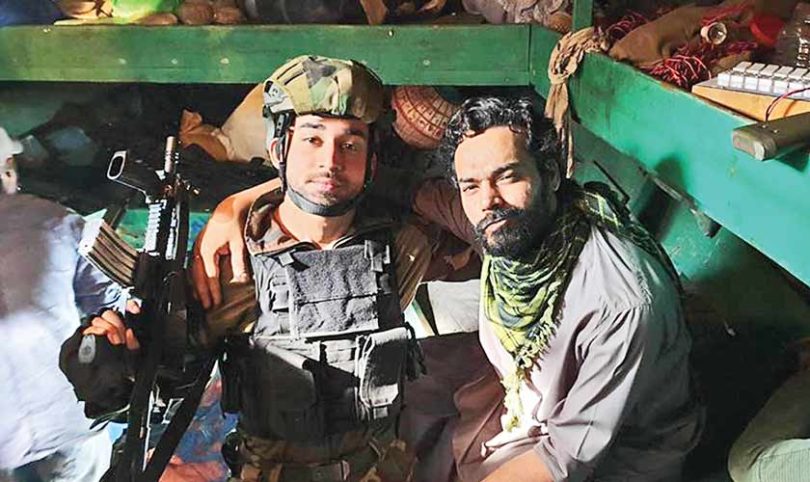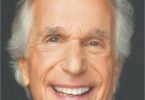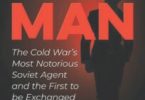Omair Alavi|Instep|September 6, 2020
As Pakistan celebrates the annual Defence Day today, Instep looks at how real-life heroism has inspired screen stories on television over the years.
Bilal Abbas Khan and Gohar Rasheed in telefilm Laal, written by Umera Ahmed and directed by Haseeb Hassan, that chartered a young boy’s life as he worked his way from being a fisherman’s son to a Naval officer and then made the ultimate sacrifice for national pride.
Patriotic content, or entertainment that gives the viewer a sense of national pride, isn’t limited to Pakistan. Hollywood has for long been making movies that push a certain agenda, whether immortalizing war heroes, documenting historical battles, or simply humanizing soldiers and their lives. India has produced more than a fair share of patriotic films that have presented true events in what we believe to be a distortion of facts and figures. One man’s patriotism, after all, can be seen as another man’s propaganda. In Pakistan, patriotic content has been best served on television, its strongest medium that has successfully brought stories of valor, sacrifice , and honor to the people.
Instep On Sunday brings you a smorgasbord of television’s best patriotic productions, often made in collaboration of the ISPR, that have gone down in history as memorable content.
Sunehray Din, 1991
It all started with Sunehray Din that introduced people to the life of a cadet. Written by Shoaib Mansoor and co-directed by Mohsin Ali, Sunehray Din started a trend, a genre of its own, that has sustained to this day.
After the serial aired on TV in 1991, people developed a new kind of love for the Armed Forces. Introducing Saleem Sheikh, Faraz Inam, Qasim Khan as well as Kiran and Aliya Kazmi, Sunehray Din was shot on military location(s) – unlike earlier PTV dramas of the 1980s and the 1990s.
Actor Faraz Inam, who played the role of Faraz in Sunehray Din, went onto reprise the role in Alpha Bravo Charlie and Ehd-e-Wafa. He is the only actor in Pakistan to essay the same character in three different dramas even as his character rises through the ranks. When asked about why he didn’t take up other characters than Faraz, the actor said that by not playing any other role, he managed to connect Faraz to the audience in a deeper sense.
“I must credit Shoaib Mansoor sahab for making ‘Faraz’ so interesting. He picked up an unknown guy like me with no acting experience and made the character a part of me for so long. He believed that I embodied this character’s persona. That’s one of the reasons why – even after 30 years – the character feels as fresh to the audience as it did when it was first introduced on that railway platform in Sunehray Din. ‘Faraz’ has grown with me, from gentleman Cadet Faraz to Captain Faraz and now Brigadier Faraz. The best part is that many people believe that Faraz is actually in the Pakistan Army, which is exactly what we wanted them to believe.”
Alpha Bravo Charlie, 1998

Faraz Inam worked his way through Sunehray Din, Alpha Bravo Charlie and then Ehd e Wafa as Cadet, Captain and finally Brigadier. We’d love to see him as General in his next foray!
Alpha Bravo Charlie has gone down in history as one of the most iconic drama serials ever. Not only did it add to the charisma of real-life soldiers played by Captain Qasim Khan (Gulsher) and Captain Abdullah (Kashif), but even after two decades, people are unable to forgive ShoMan (short for Shoaib Mansoor) for Gulsher’s “needless” death.
Shot in the northern areas of Pakistan (most notably Siachen) as well as in war-hit Bosnia, who can forget Kashif’s electrifying stunt that required him to hang from a helicopter or Faraz’s Mercedes that had many making fun of him in the earlier episodes?
Wilco, 2006
With Wilco, Humayun Saeed – currently one of Pakistan’s best actors (and among the most prolific producers) – made his debut into the world of the Armed Forces, as a lead actor and producer. He had earlier played a supporting role in Ghazi Shaheed (more on that later), but with Mohammad Ahmed writing and Aehsun Talish calling the shots, Wilco managed to captivate the audience because of its action sequences, high production value and ensemble cast.
“I have always been attracted to the Armed Forces,” Humayun Saeed spoke exclusively to Instep. Before I became an actor, I applied for both Army and Air Force and appeared in the ISSB examinations. My late mother wished to see me in the uniform as well. So, whenever I get a chance to play such a role, I am grateful for it. I am thankful that I was part of Ghazi Shaheed in the late ‘90s and Ehd-e-Wafa (in a special appearance) as recently as 2020. Wilco was my co-production with ISPR and I would term it as a wonderful experience. I consider myself lucky to have played both the Army and Navy guy on screen and whenever the Armed Forces would require my services, I would be there for my country.”
Ehd e Wafa, 2019

Featuring Ahad Raza Mir, Osman Khalid Butt, Ahmad Ali Akbar and Wahaj Ali, Ehd e Wafa mapped the story of four friends who started out at Lawrence College Murre and then despite going their own way, unite to overcome hardships in their lives. Out of the four, Saad, essayed by Ahad Raza Mir, went on to become an army officer.
After a hiatus of many years, patriotic content returned to TV screens last year with Ehd-e-Wafa, a drama that was very well received for its strong cast and it’s light-hearted, uplifting, and colorful treatment. It may have taken ISPR some time to come up with something this big, but the wait was worth it. With Mustafa Afridi writing and Saife Hasan directing, Ehd-e-Wafa was always in safe hands. They not only made Faraz Inam reprise his role as Brigadier Faraz but also inducted some of the best actors from the industry at present; Ahad Raza Mir, Alizeh Shah, and Adnan Samad Khan all played army officers.
Mustafa Afridi, the writer behind the super successful Ehd-e-Wafa, believes that the audience’s love-affair with the Armed Forces was one of the many reasons why they connected with Ahad Raza Mir’s character in the drama.
“The good work of previous plays thematically based on the Armed Forces helped us in many ways; we knew how to progress this time around and what kind of humor or action to portray. Having a young cast benefitted the whole production as each and every person was committed and raring to give his 100%. The decision to continue the ‘Faraz’ legacy was a mutual one; there could have been nothing better than his own son making the country proud.”
Ghazi Shaheed, 1998
Pakistan Navy isn’t far behind when it comes to dramatic adaptations of its missions. In the late 1990s, both Ghazi Shaheed and Operation Dwarka entertained the audience with impeccable writing, brilliant performances, and near-perfect execution. It was the first time that an Armed Forces ‘tragedy’ was adapted for TV since the submarine failed to return after completing a successful mission in reality. The way it was presented on screen was memorable – for the first time, an underwater sequence was shot in Pakistan. Led by Shabbir Jan, the cast included Adnan Jeelani, Humayun Saeed, Ghalib Kamal, Shehzad Raza, Rizwan Wasti to name a few who did complete justice to Asad Mohammad Khan’s script that was well executed by veteran TV director Kazim Pasha.
Operation Dwarka, 1998
Operation Dwarka, a collaboration of PTV and Pakistan Navy, revolved around one of the most successful missions of the latter. Qasim Jalali executed Hameed Kashmiri’s script perfectly as director and you can’t go wrong when you have veterans such as Talat Hussain, Shakeel, Talat Iqbal, Qazi Wajid, Rizwan Wasti, and Zahoor Ahmad in the cast along with Sami Sani who played a young naval officer. The scenes on the battleships as well as on the ground took the audience on a nostalgic ride, especially those who had read about the mission, but had no clue what went on in the battle. It was executed to perfection.
Laal, 2019
Telefilm Laal – written by Umera Ahmed and directed by Haseeb Hasan – was the first Navy project to hit the screens in two decades. Starring Bilal Abbas Khan, Kubra Khan, Saleem Meraj, Gohar Rasheed, Iffat Rahim, Adnan Shah Tipu, and Adnan Jaffar, the narrative was based on the life of a youngster who defies all odds to serve his country and make his loved ones proud. It wasn’t the first time that Adnan Jaffar donned the uniform; he had earlier played a PAF officer in Parwaaz Hai Junoon, and later shocked his compatriots by playing an Army officer in the American TV show, Homeland, earlier this year.
Director and producer of Laal, Haseeb Hasan feels honored on being the only director to have worked with all three branches of the Armed Forces.
“It is my privilege to be the only director to have worked with all three branches of the Armed Forces,” he spoke to Instep. “Sher Dil was Air Force’s foray into TV for the first time since Shahpar; Laal was the first telefilm made in association with Pakistan Navy in two decades whereas I have been facilitated by the Pakistan Army in my upcoming web series, Dhoop Ki Deewar. In addition, I had done Parwaaz Hai Junoon for cinema, which was PAF’s first film in 50 years. It is always an honor to highlight the lives of the defenders of Pakistan in a positive light because they sacrifice a lot for us, and it is our duty to encourage them whenever we can.”
Shahpar, 1997
While Hollywood was producing Top Gun and American TV was dominated by JAG, Pakistan Television wasn’t far behind; they developed their own version of Top Gun and JAG, combining elements from both to create Shahpar. Featuring Faisal Rehman as an Air Force pilot, followed by real-life PAF officers Flight Lieutenant Sarfaraz Usman, Flight Lieutenant Arif Kazmi, and Group Captain Sultan Mehmood Haali, Shahpar told the story of one PAF officer in search of his ‘missing’ father, while being trained to be the best in the world. Written by Mustansar Hussain Tarrar and directed by Qaiser Farooq and Syed Shakir Uzair, people remember Shahpar as Faisal Rehman’s comeback to acting and his death scene was so shocking that even after two decades, people are unable to forget its impact.
Sher Dil, 2008
After Shahpar came Sher Dil, another PAF production that was penned by Amjad Islam Amjad and directed by Haseeb Hasan. Revolving around the lives of cadets and officers, it educated the audience on many levels, discussing the private lives of soldiers and what issues they faced back home due to their prolonged absence. It was this project that made PAF go for Haseeb Hasan when they were thinking of producing Parwaaz Hai Junoon.
For musician-turned-actor Alamdar Khan, it was a special moment as he returned to the PAF Academy for both Sher Dil and Parwaaz Hai Junoon, after leaving PAF to pursue a career in showbiz.
Actor Sami Khan, who also played a cadet in Sher Dil, recalled the memorable time he spent at the Academy and how he still cherishes those days after more than a decade.
“When I was offered Sher Dil, I was a rookie to acting but the charm of playing a cadet in the Armed Forces was enough to lure me as I have immense respect for the forces. Our soldiers leave their normal lives to protect us and the least we can do is portray them on-screen and tell them that the whole nation is proud of them. Before Sher Dil, not many TV dramas or films revolved around the PAF and that factor made it different from other productions on-air.”
Eik Thi Marium, 2016
Sher Dil was followed by Umera Ahmed’s Eik Thi Marium where Sanam Baloch played Marium Mukhtiar, Pakistan’s first female fighter pilot to attain martyrdom in the line of duty. Directed by Sarmad Khoosat, the telefilm featured Hina Khawaja Bayat, Behroze Sabzwari, Shermeen Ali, Agha Mustafa Hassan, and Sajida Syed as Marium’s extended family.
It revolved around Marium’s love for the Pakistan Air Force, how she convinced her parents to let her join the PAF and how she excelled before her promising career was cut short by a tragedy. Ek Thi Marium was also screened in cinemas later on and made many women realize that when it comes to the Armed Forces, everyone is treated as an equal.
There are many more projects, especially for cinema, that did not have the intended impact and fizzled out. While Waar managed to surprise the audience with its well-executed action sequences, its follow-up Yalghaar wasn’t able to garner the same effect at the box office.
On the other hand, Haseeb Hasan’s Parwaaz Hai Junoon went onto become the highest-grossing ISPR production despite its flaws; Saya e Khudaye Zuljalal and Project Ghazi came and went without making an impact at all. There was one Kaaf Kangana released last year but was so bad that the audience couldn’t believe that it was an ISPR production.
One hopes that in future, real-life stories of valor and sacrifice are brought to screens – both TV and film – with the kind of finesse and grandeur that the subject deserves.







